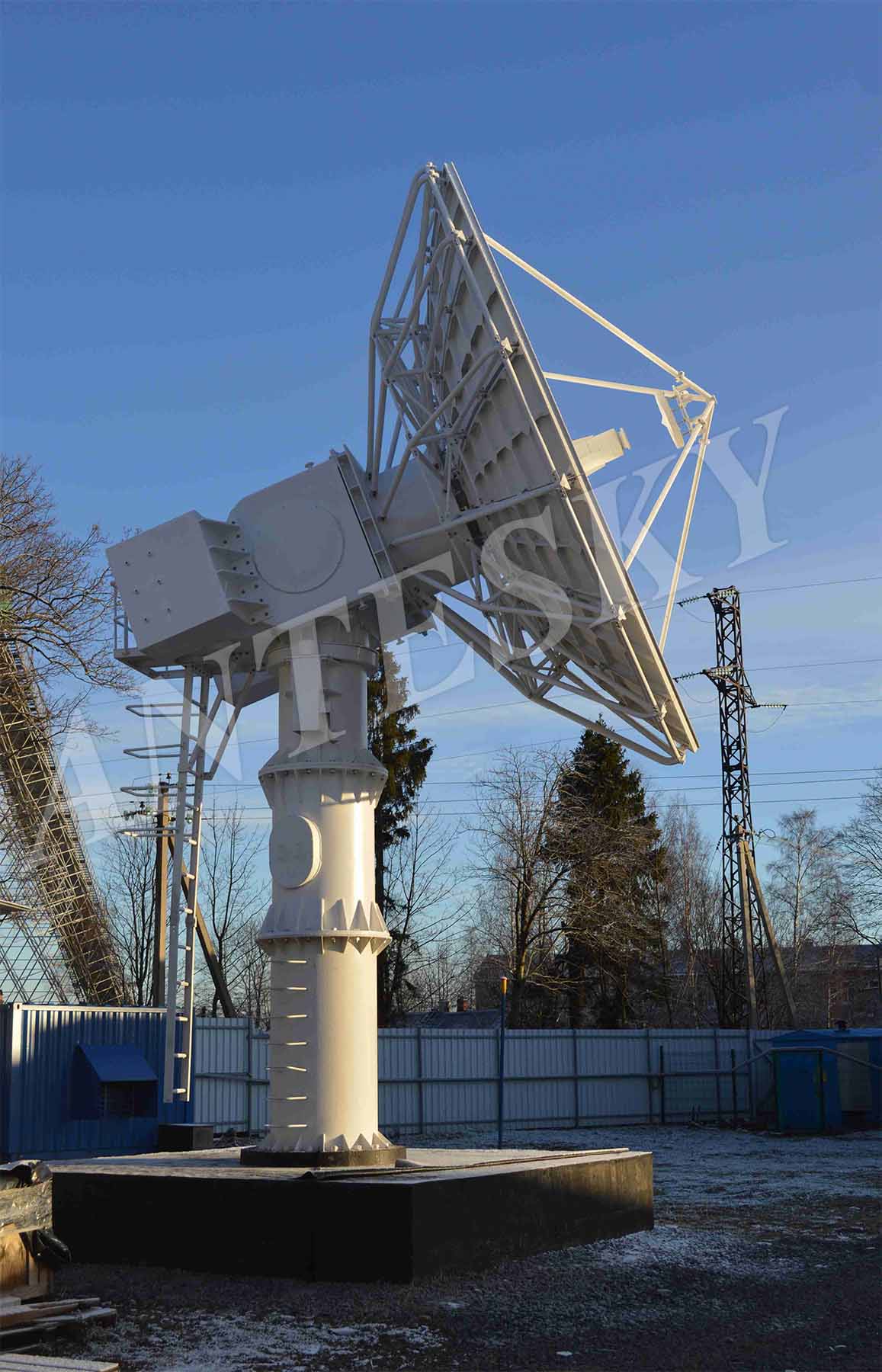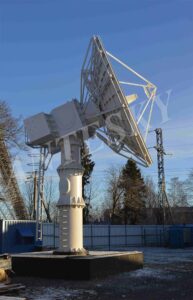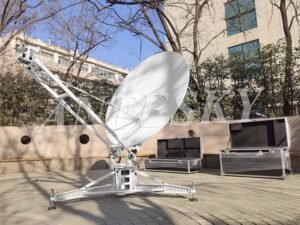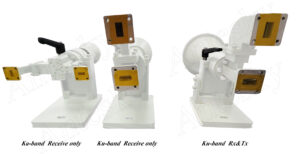
1. Introduction and application of Ka-band antenna
KA band antenna refer to antennas that work in the KA band (26.5-40 GHz). The KA frequency band is a frequency band in wireless communication, mainly used for high-speed data transmission and satellite communication. KA band antennas generally have higher gain and smaller beamwidths to enable longer distance communications and higher data transfer rates. Such antennas are commonly found in satellite communications systems, wireless communications equipment, and radar systems.
The KA band antenna is mainly used for the satellite communication ground station in the satellite communication system. Satellite communication ground station refers to the equipment used to communicate with satellites, including antennas, transmitters, receivers, etc. Know more details, please click this link.
KA band antennas are widely used in satellite communication ground stations to receive signals from satellites and send signals to satellites. Specific applications include:
- Home satellite TV receiver:
The KA band antenna can receive satellite TV signals, enabling home users to watch satellite TV programs.
- Enterprise communication:
KA frequency band antennas can be used in enterprise satellite communication systems to realize functions such as enterprise internal communication and data transmission.
- Military communication:
KA frequency band antennas can be used in military communication systems to realize functions such as communication and command between armies.
- Emergency rescue communication:
KA band antennas can be used in emergency rescue communication systems to realize communication and rescue work during disasters.
- Aviation communication:
KA frequency band antennas can be used in aviation communication systems to realize communication between aircraft and ground stations.
In short, KA frequency band antennas are widely used in the field of satellite communications, providing people with high-quality communication services.
As a professional and reliable supplier of satellite communication products in China,, and Antesky has been involved in antenna projects all over the world. The most classic one is the Antesky 1.8m ka band antenna with portable flyaway type. We provide single receiver series, transceiver series, and KA and KU replacement feed series of 1.8m flyaway antenna according to customer needs. These products are well received by customers, and customers also expressed that they will further cooperate with us for more projects.
Antesky 1.8m ka band antenna with Quick Deploy Flyaway
Display of KU &KA band feed for 1.8m ka band antenna with manual flyaway
Antesky Newly Launched 1.2m Ka-band Flyaway Antenna
For fixed earth station antenna series, we have a 6.2m X&KA dual-band antenna project in Europe, so far the antenna operates well with local network. This dual-band antenna system is equal to one 6.2m ka-band antenna system and one 6.2m ku-band antenna system
 6.2m X&KA dual band antenna on site
6.2m X&KA dual band antenna on site
Application and development of Ka-band antenna in communication satellites
Based on the characteristics of high Ka-band throughput and larger data transmission volume, communication satellites can provide end consumers with low-latency, high-speed data connection services. Recently, major communication satellite operators have begun to increase the Ka-band Investment, construction and launch of a series of Ka-band satellites.
Like other communication satellites in the working frequency band, Ka-band communication satellites mainly target markets that cannot be covered by the ground communication network, as a supplement to the ground communication network system. The main application scenarios include: voice SMS service in remote areas, sea/onboard Internet connection service, community Internet service, emergency communication, TV broadcast service, Internet of Things data transmission, company/government agency intranet, etc.
The development of GEO orbit Ka-band communication satellite technology together with ka-band antenna system is relatively mature, the business model is clear, and there are many competitors in the business market. However, limited by the number of satellites and their orbits, the coverage of GEO satellites is limited, and most of them are regional operators.
Table 1 Ka-band GEO communication satellites in orbit
| Satellite operator | Satellite | Launch time | Main service area | Remark |
| Viasat | WildBlue-1 | 12/2006 | North America | 35 Ka wave beam |
| ViaSat-1 | 10/2011 | US, Canada | total capacity 140Gb/s | |
| ViaSat-2 | 06/2017 | North America, Central America, Routes between America and Europe | total capacity 350Gb/s | |
| NBN | Sky Muster 2pcs/NBN-Co 1A, 1B | 10/2015
10/2016 |
Australia | total capacity 135Gb/s |
| Avanti | Hylas-2 | 08.2012 | America, Eastern Europe and Middle East | 24 Ka transponders |
| Al Yah | Yahsat-1B | 04.2012 | Middle East, Africa, Europe, Southwest Asia | 25+21Ka transponders |
| EchoStar/Hughes | EchoStar17/Jupiter 1 | 07/2012 | North America |
Multiple spot beam high throughput Ka-band load |
| EchoStar19/Jupiter 2 | 12/2016 | North America | ||
| Eutelsat | Eutelsat
Konnect |
01/2020 | Africa, West Europe | total capacity 75Gb/s |
| KaSat | 12/2010 | Europe, part of middle east | total Ka capacity 90Gb/s | |
| Kacific | Kacific 1 | 12/2019 | Asian-Pacific region | 56 Ka wave beam: total capacity 1.25Gb/s |
| Inmarsat-5 | Inmarsat-5 series the first 4 satellites | 2013-2019 | Global | 89 Ka wave beam(the first 4 satellites), 72 wave beam (the fifth satellite) |
| China Satellite Communication Co.,ltd | Zhongxing-16 | 04/2017 | China and offshore areas | China’s first high-throughput satellite: total capacity 20Gb/s |
In addition to the above-mentioned full Ka-band satellites(matching ka-band antenna system), there are also high-throughput GEO satellites working in the Ka/Ku frequency band or C-band at the same time, which are mainly used to provide satellite TV broadcasting services, including Anik F2 and F3 of Telesat in Canada, European satellite company (SES ) AMC15, 16 and Serius 4/Astra 4A, Intelsat’s Galaxy-28/Intelsat Americas 8/Telstar 8, etc.
Compared with the well-developed GEO communication satellites, the LEO broadband satellite constellation is still in the exploratory stage, but the development prospects are worth looking forward to. Although OneWeb recently fell into bankruptcy, SpaceX’s Starlink project is still attracting attention. In March this year, it launched the sixth group of satellites, and the number of satellites in orbit has reached 360. In addition, Iridium’s second-generation Iridium system entered the commercial operation stage in 2018, mainly providing voice and data services covering the world. The domestic Ka-band low-orbit broadband satellite program includes the “Hongyan” constellation of Aerospace Science and Technology, the “Hongyun” constellation of Aerospace Science and Industry, and the Galaxy Aerospace low-orbit mobile communication constellation. At present, the above three constellations have also successfully launched their first satellites. In broadband satellite constellation systems, the Ka band is used both for downlink feeder links and for inter-satellite links.
In addition, MEO communication satellites and GEO communication satellites present a complementary trend. For example, in MEO orbit, only the O3b constellation is currently in operation, which is equipped with 12 Ka-band antennas per satellite. It has been in commercial operation since 2014, and was acquired by SES as a subsidiary in 2016. The company plans to continue launching the MEO satellite constellation mPower in 2021, combined with its existing GEO satellites, to provide higher-speed and lower-latency broadband services. ViaSat also proposed to deploy the ViaSat-3 constellation consisting of 20 satellites in MEO orbit, combined with the company’s GEO satellite capacity to optimize user experience.
Above is the introduction and development for Ka band and Ka band antenna& satellite. We hope it is helpful for you to learn further about satellite communication industry. Welcome to talk ka-band antenna system with us via sales@antesky.com. Thanks!









